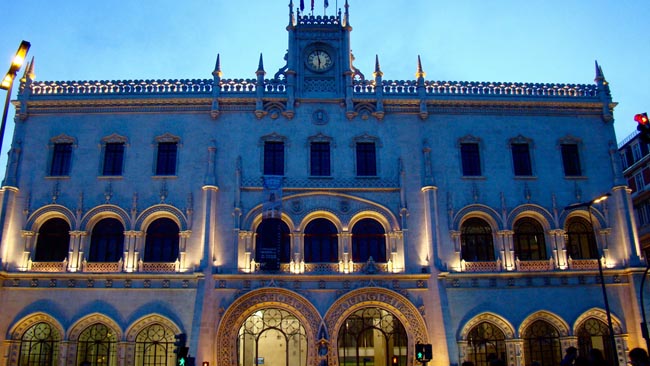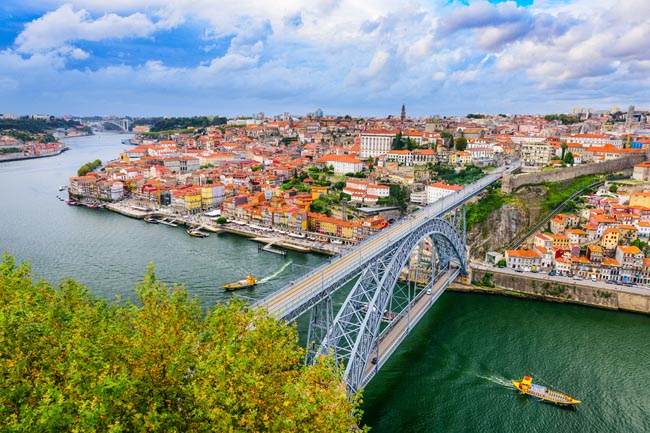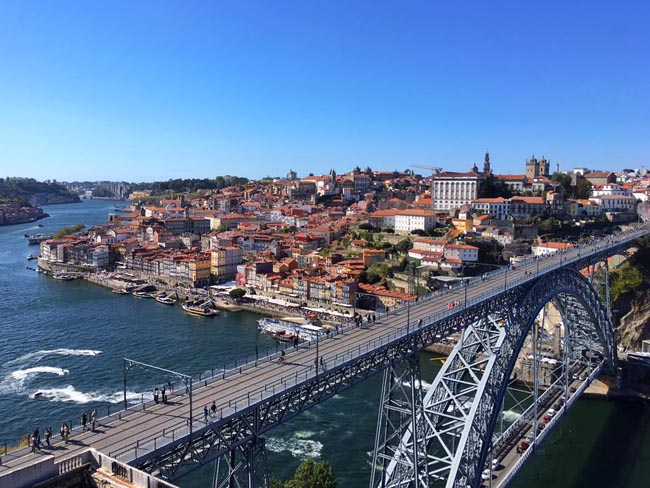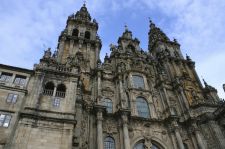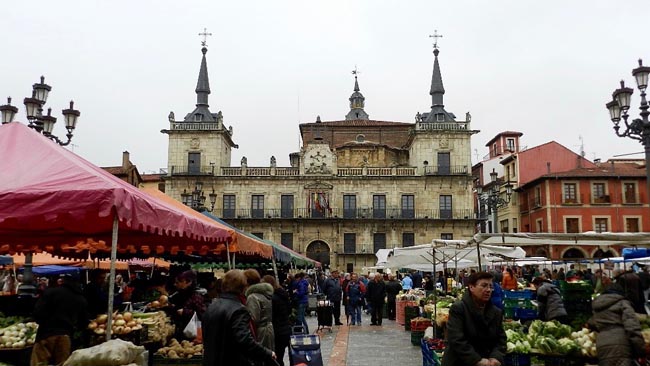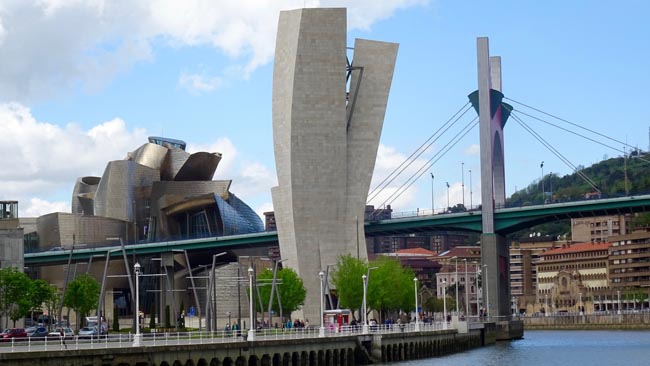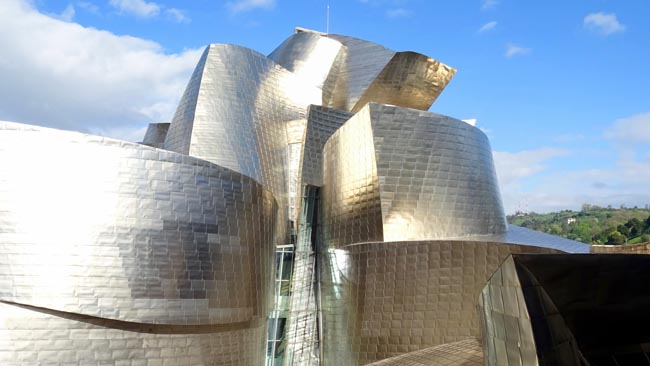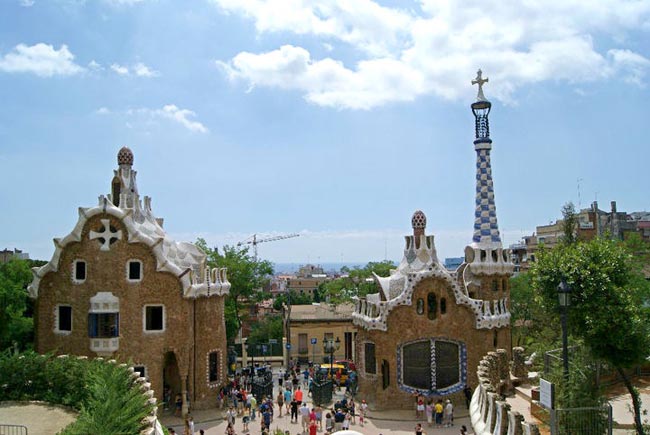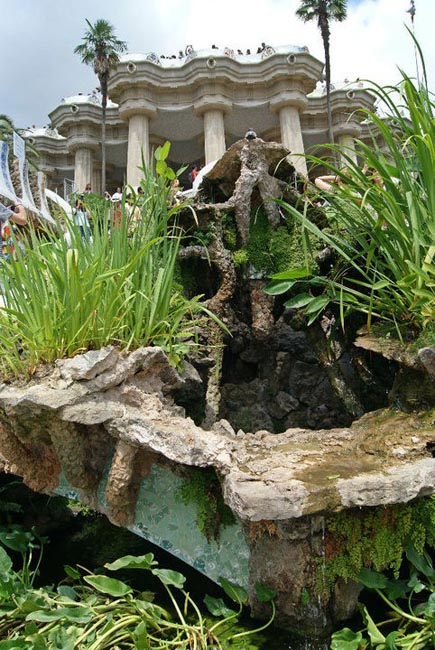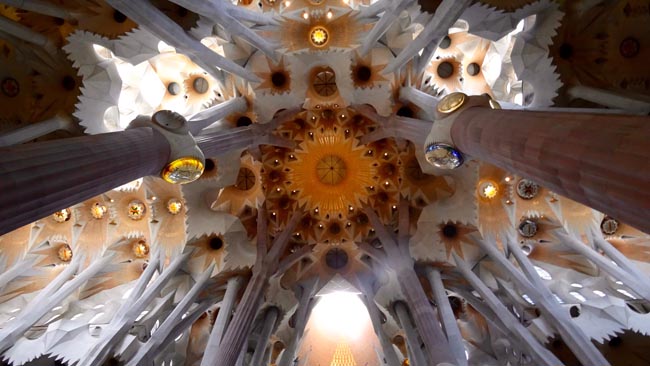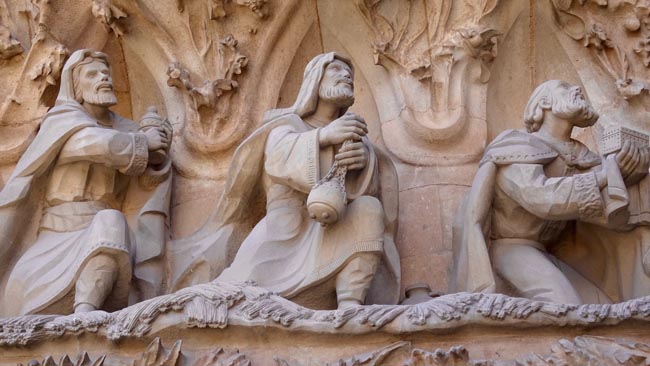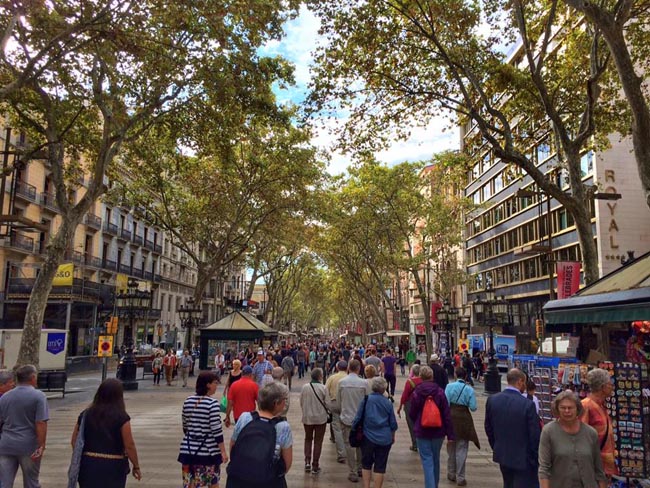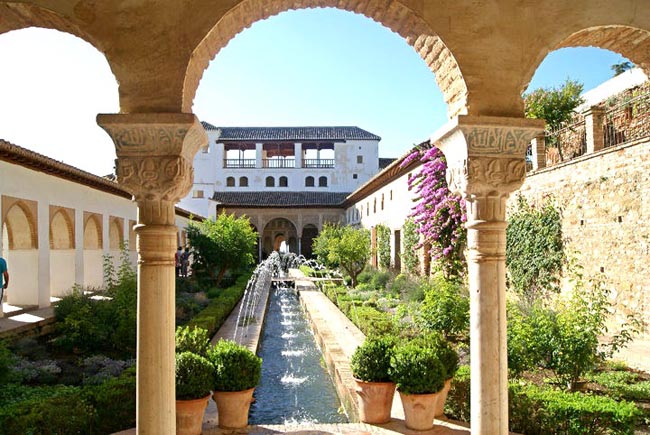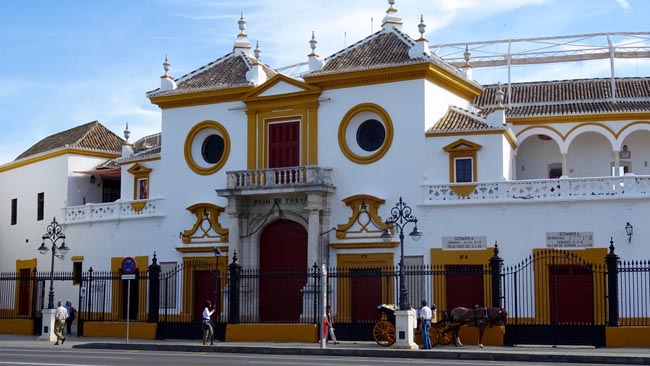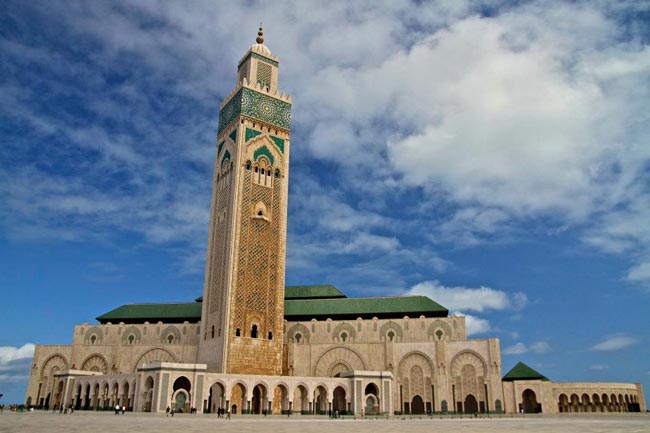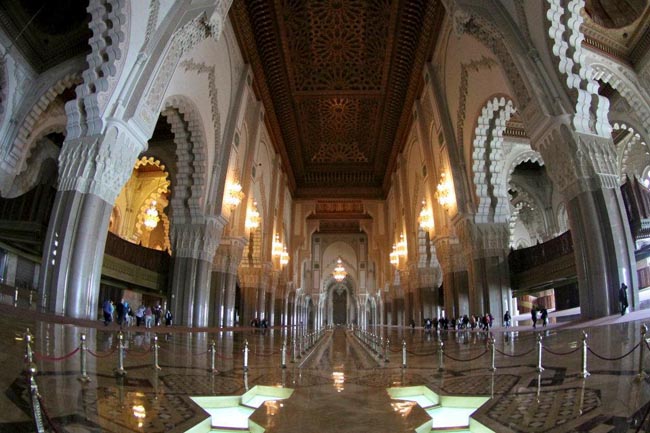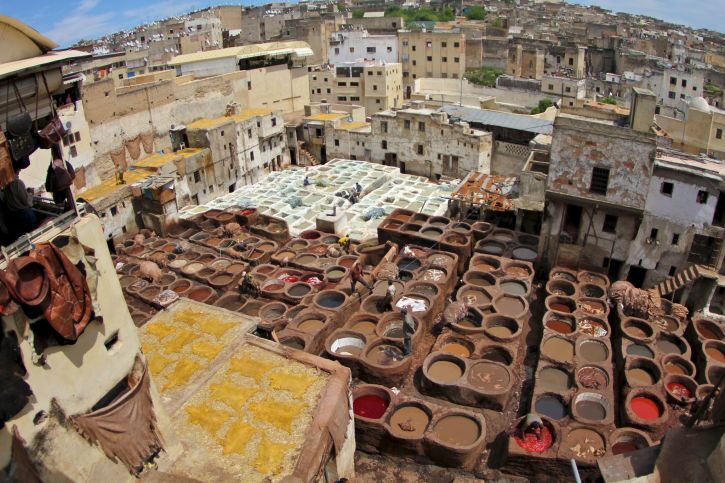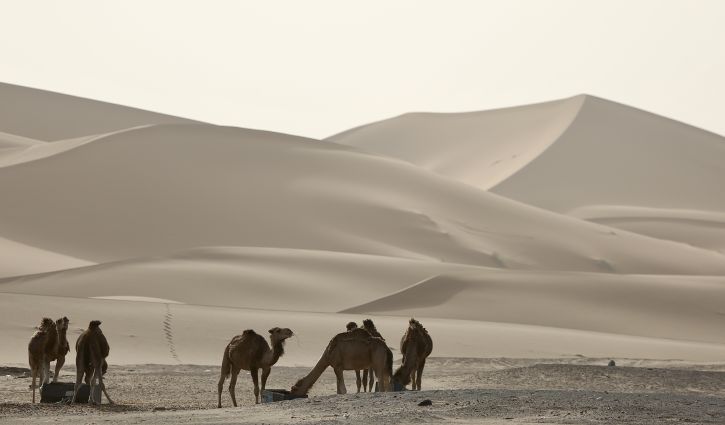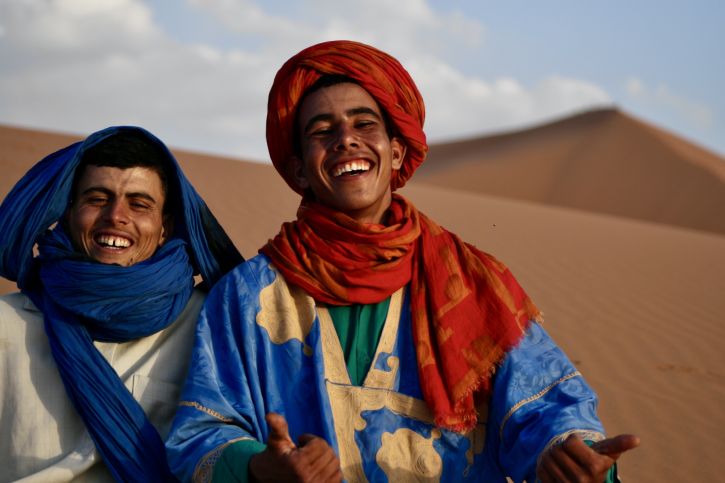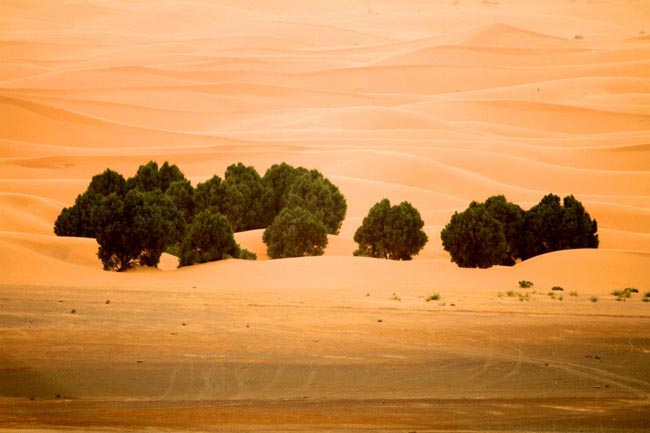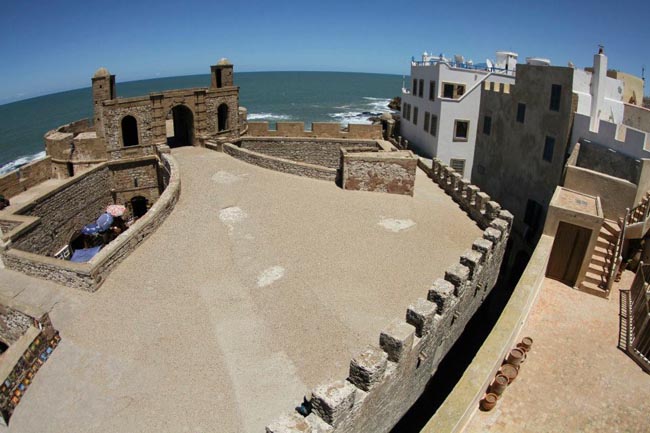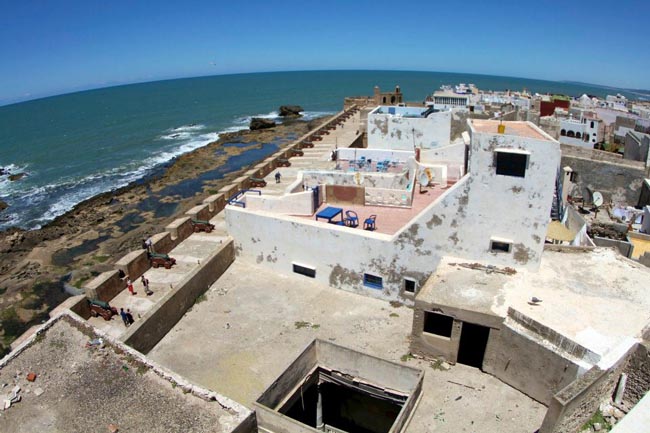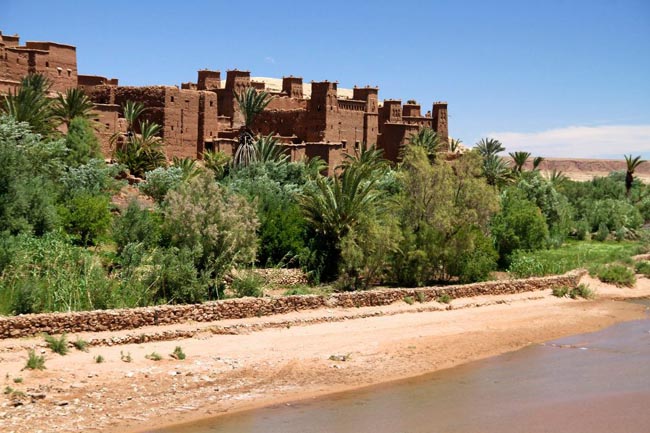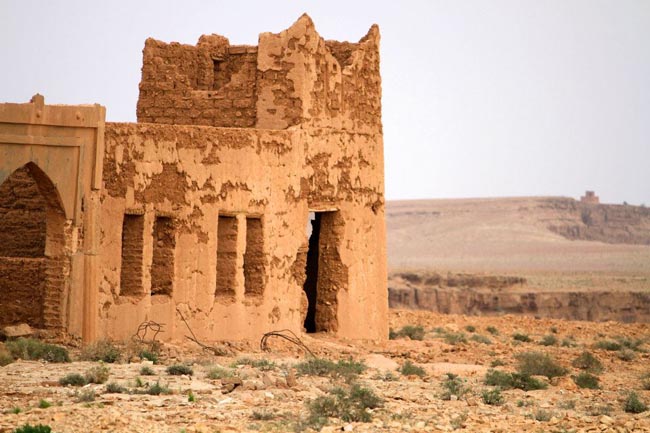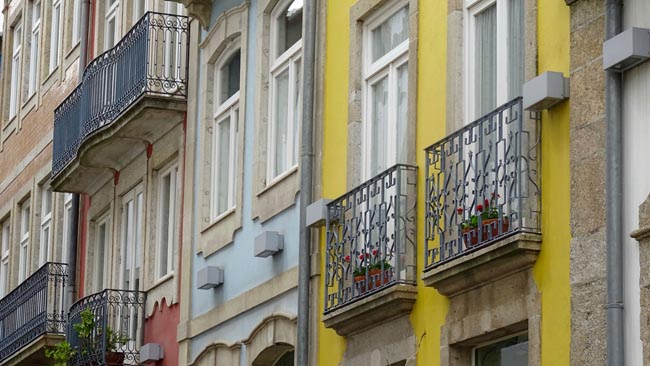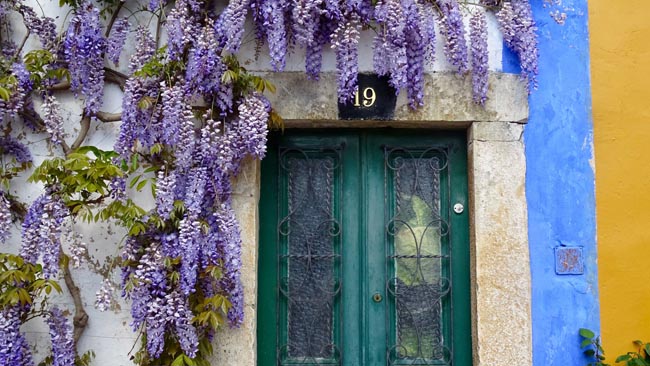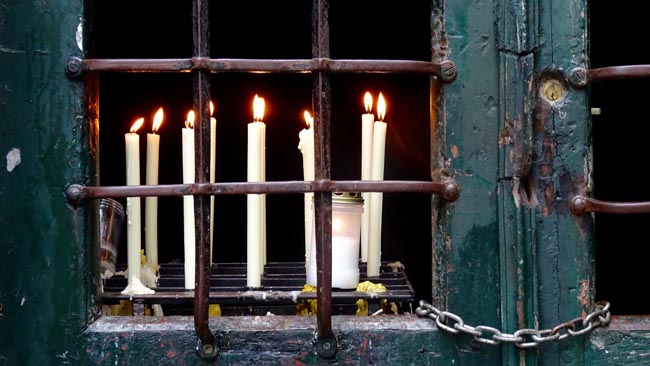If we are to conjure up images of Portugal, we might picture white-stone balconies supporting various arrangements of flower pots.
When thinking about Spain, we might imagine towering cathedrals.
Morocco brings to mind large dunes of glowing-orange sand that slowly fades as the sun sinks behind them.
This 37-day Portugal, Spain & Morocco Tour is the perfect opportunity for those who are slightly curious to take the chance in experiencing these details first-hand rather than relying on flights of the imagination that could never do these countries justice.
Come see the streets of Lisbon, Portugal, the Gothic Cathedral of Segovia, Spain, and the majesty of the sand dunes in Merzouga, Morocco, and bring new definition to what you imagine these stellar destinations to be about.
Prices below are per person, twin-sharing costs in US Dollars (USD). Pricing does not include airfare to/from the tour and any applicable taxes. For single supplement rates and taxes (if any), please refer to below Prices & Dates table. For general information on flights to/from the tour, click here.
Your Travel and Accommodation Arranged For You
Tips Included for Driver, Restaurant Staff, Local Guides
Authentic Local Experiences With Lots Of Inclusions.
Select a date below to reserve your spot:
Optional Single Supplement: $2670 USD (number of singles limited).
This tour may require a mandatory single supplement charge of $1340 if you join our share program and we are unable to pair you.
Download Itinerary
Day 1 Arrival in Lisbon
Today we arrive in Lisbon.
The capital of Portugal since its conquest from the Moors in 1147, Lisbon is a legendary city with over 20 centuries of history. This was the centre of Europe's first and largest overseas empire and, as a result, the city still has a feeling of colonial elegance.
Overnight in Lisbon.
Included Meal(s): Dinner
Day 2 Lisbon: City Tour
Today we explore Lisbon, Portugal’s hilly capital. Lisbon is Europe's second-oldest capital (after Athens), once home to the world's greatest explorers like Vasco da Gama, Magellan and Prince Henry the Navigator, becoming the first true world city, the capital of an empire spreading over all continents, from South America to Asia.
This city is truly an enticing tangle of past and present, funky and old-fashioned, restored and revitalized. For many this is one of Europe's most enjoyable cities. We will explore many of Lisbon's most colourful neighbourhoods on foot. Bairro Alto and Chiado are picturesque working class quarters dating from the 16th century that have traditionally been the city's bohemian haunt of artists and writers. A stroll through the Moorish Alfama district takes us through a tangle of medieval streets topped by São Jorge Castle. Baixa is Lisbon’s historic downtown (lower town), gridded with streets and dotted with major squares.
You will have some free time this afternoon for independent exploration. If you'd like to explore Belem and Jeronimos Monastery, please consult with your Tour Leader on to best accomplish this optional activity, noting that we do not include it with our formal group program due to long waits and crowding. Should authorities introduce changes to reduce congestion, this site may be reintroduced on a TBA basis.
Overnight in Lisbon.
Included Meal(s): Breakfast and Dinner
Not finding what you're looking for?
Our specialists can take away the stress and create a private custom tour tailored to your exact interests and budget.
Day 3 Lisbon - Obidos - Nazare - Fatima - Leiria
Today we travel by road northward to Obidos, a medieval symbol of narrow streets surrounded by walls. Obidos is known for its typical white houses with blue trim, flowered windows, narrow streets and steps paved with beautiful stone. On arrival in Obidos we embark on a walking tour, passing through the 18th century entry arch covered in glazed tiles (azulejos). Small bright white houses lining narrow cobblestone streets, flower pots on window-sills, Gothic and Renaissance churches -- especially the beautiful Church of Santa Maria -- reminds of the importance of Obidos's past.
We continue to Nazare, the most famous fishing town in Portugal. En route we can detour to Batalha for a photo stop at its famous monastery before enjoying the brightly coloured rowing-boats moored on the beach bathed by the Atlantic Ocean. A superb view is enjoyed from the "Sitio" for where you may observe women still wearing the traditional seven-skirted costumes near the Nossa Virgem de Nazare Basilica, an important pilgrimage centre.
Our final stop is nearby Fatima, the well-known Roman Catholic Marian shrine. We visit the Basilica and the Chapel of Apparitions that marks the spot where the three shepherd children had visions in 1917. We continue to Leiria, a charming town with small homes over archways and behind graceful arcades.
Overnight in Leiria.
Included Meal(s): Breakfast and Dinner
Day 4 Leiria - Coimbra - Bussaco - Viseu
This morning we travel to the university town of Coimbra, home to a long, rich history, culture and centuries-old architecture. And, of course, a world-renowned university, the oldest in Portugal and one of the oldest in Europe. This was Portugal’s medieval capital for more than a century; its steeply-stacked historic centre dates to Moorish times and is wonderfully atmospheric, with its dark cobbled lanes and monumental cathedral.
We visit the 12th century Se Velho Cathedral and 13th-century university with its magnificent library, Manueline doors and chapel. We also visit the Alameda Gate, the Cathedral, Santa Cruz Church, and the Machado de Castro Museum, mostly to see the Roman Tunnels on which the museum is built.
After a break for lunch and some free time, we continue to the nearby small town of Bussaco, known for its collection of national and imported trees -- over 400 native species of plants and 300 varieties brought home by Portuguese explorers from such far flung places as Mexico, Japan and Africa. The Portuguese royal family liked Bussaco forest so much they had a summer palace and hunting lodge built in the centre of the woods, now a posh hotel (which may or may not be open to non-residents). This was also the site of the 1810 Battle of Buçaco, where Napoleon's troops were defeated, marking the turning point in his attempted invasion of Portugal; the Duke of Wellington slept in the convent during the conflict.
After about an hour to stroll and perhaps enjoy a coffee or an ice cream, we'll depart Bussaco for Viseu.
Overnight in Viseu.
Included Meal(s): Breakfast and Dinner
Day 5 Viseu - the Douro Valley - Porto
This morning we'll walk through Viseu's historical zone. The city's name goes back to the end of the Roman Empire and the early Middle Ages, and is derived from the Roman term "viso," meaning "good view." Indeed, original settlement was located at its highest point. Of the various monuments we encounter on our stroll, the three highlights are are the Cathedral, the Misericordia Church, and the Synagogue.
We then continue on a picturesque drive through a landscape speckled with granite houses with wooden or wrought-iron balconies, before entering the Port Wine region, the Douro Valley, a UNESCO protected site. This was, in fact, the world's first demarcated wine region, established in 1756. Evidence of the port industry can be seen along the valley with all the famous company names -- Cockburns, Taylors, Sandeman and others -- appearing on large placards on the hillsides.
En route we will stop for a cellar tour, tasting, and lunch (included today).
We will also stop in Amarante to visit the local market before continuing to Porto (dinner on your own this evening).
Overnight in Porto.
Included Meal(s): Breakfast and Lunch
Day 6 Porto: City Tour
Today will be spent exploring Porto (Oporto), the ‘2nd city’ of Portugal.
Located along the Douro river estuary in northern Portugal, Porto is one of the oldest European centers, and the atmospheric ancient port is steeped in history and tradition. With 2,000 years of history, the settlement of the city dates back to when it was an outpost of the Roman Empire. During the Roman era the city gained prominence as a commercial port, primarily for trade between Lisbon and Braga. Today the western part of the city limits extend right to the coastline of the Atlantic Ocean.
The city was built along the hillsides overlooking the mouth of the Douro River, and has an outstanding urban landscape. The continuous growth of the city has always been linked to the sea (the Romans gave it the name Portus, or port), and can be seen in the many and varied monuments. Porto is rich with well-preserved treasures, including monuments in the Romanesque, Gothic, Baroque and Neo-classical style. The historical center of Porto preserves a strong identity forged over many centuries, and in 1996 UNESCO included it on its World Heritage list. Strategically close to the Atlantic coast, at a natural intersection of the routes travelled by people from both north and south, the city has always played an important role in international trade.
We will wander through Porto's lively city center, and see the Old Quarter, the modern districts, and the low section that fronts the River Douro. Our walking tour of Porto's riverfront Ribeira district will include the lavish rooms of its neoclassical Stock Exchange Palace, the exquisitely gilded Church of Santa Clara (closed for renovation - outside only), the Cathedral and the São Bento Train Station. The alluring district of Ribeira is a crumbling but fascinating place made up of medieval streets and alleyways, including the riverfront square ("Praça da Ribeira"). During our time here we will see the Church of Sao Francisco which dates to the 13th century. Along with being the second-largest Portuguese city after Lisbon, Porto is also one of the most prominent urban areas in Southern Europe.
This afternoon we will leisurely cruise along the Douro River.
Overnight in Porto.
Included Meal(s): Breakfast and Dinner
Day 7 Porto: Braga & Guimaraes
Today we visit Braga, a city famous for its churches, last count surpassing 300! As the religious centre of Portugal, Braga boasts the highest number of churches per capita in Christendom. The strategic location has always made it ripe for occupation and development. The Goidelic Celts, also known as the Bracari, are believed to have founded the city and given it a name several thousand years ago. The Romans occupied it in 250 BC and made it the hub of five major roads, all leading to Rome. The Suevians overran the city in AD 409 but were replaced in 485 by Visigoth invaders, who, in turn, were vanquished in 711 by a Moorish army. For more than three centuries, the Christians and the Moors jousted over Braga, until the Muslims were finally expelled at the end of the 11th century.
Our time in Braga includes the area's star attarction, the Santuário do Bom Jesus do Monte (a World Heritage Site), a spectacularly-situated church built in 1784 by Carlos Amarante, who gave it an Italian-inspired neo-classical design that integrates harmoniously the landscape of northern Portugal. The stairway leading to the top contains 17 landings adorned with symbolic fountains, allegoric statues and other Baroque style decoration. Looking upwards, there are the ornate granite fountains on the various landings and the white, chalice-shaped outline on which the church itself "sits". Our trip to the top is interesting unto itself, as the funicular we ride was the first to be built on the Iberian Peninsula. Indeed, it is the oldest funicular in the world powered by water counterbalancing.
In the old quarter of Braga, you'll have a chance to admire the ornate Renaissance and Manueline palaces, baroque churches, and narrow medieval streets.
After a break for lunch we proceed to Guimaraes, birthplace of Portugal's first king and for 2012, European Capital of Culture. In this charming town (a UNESCO site) we offer a walking tour of the old mediaeval quarter. We begin in the Largo da Oliveira, with its varying styles of architecture. As we walk through the Old Quarter, notice the window boxes with fresh, colourful spring flowers. On our walk you will see workshops, bakeries, stores, and the like operating like time has never passed.
Overnight in Porto.
Included Meal(s): Breakfast and Dinner
Day 8 Porto, Portugal - Santiago de Compostela, Spain
Today we travel by road to Santiago de Compostela.
Built of golden granite, Santiago is one of the most beautiful of all Spanish cities. The medieval city has been declared in its entirety a national monument, and remains remarkably integrated, all the better for being almost completely pedestrianized. The buildings and the squares, the long stone arcades and the statues, are hewn from the same granite blocks and blend imperceptibly one with the other, often making it impossible to distinguish ground level from raised terrace.
En route we make a stop in Baiona, one of the most important coastal towns in Galicia because of its harbour and fishing fleet. The caravel Pinta landed here on her arrival back in Europe from Columbus's "discovery" of America. You'll have some time for enjoying a coffee or some Spanish tapas as well as local shopping.
Depending on our time of arrival, we may accomplish some of our sightseeing today after we check in to our hotel.
Overnight in Santiago de Compostela.
Included Meal(s): Breakfast and Dinner
Day 9 Santiago de Compostela: City Tour
This morning we have a walking city tour of Santiago, a UNESCO World Heritage city. Our tour begins at Obradoiro Square where some of its more prominent monuments can be seen: the Archbishop's residence which preserves some 12th century lounges; the Town Hall, former Raxoy Palace, with its classical facade; the San Jeronimo College, whose facade shows Roman influences.
We also include the city's famous cathedral, a truly grand building adorned with many statues of St James in his familiar pilgrim guise with staff, broad-brimmed hat, and scallop-shell badge.
We also visit the Cathedral Museum, the Cloister and finally, the Platerias Gate, the only Romanesque one that is still preserved; and we take a guided tour of the Cathedral roofs,* which allows us to climb to the very top of the building and look out over the historic centre from the heights. To do so we make for the Gelmirez Palace, located to the side of the Cathedral in the Plaza del Obradoiro square. We pass through the interior of the Gelmirez Palace, past the Cathedral gallery (above the Gloria doorway) and up to the roof of the cathedral.
* Impending maintenance on the roof has been announced starting from late winter 2018, and it is unclear as to how long a closure may last. Please be advised that this element may not be possible if the roof tour is unavailable for your chosen departure.
Overnight in Santiago de Compostela.
Included Meal(s): Breakfast and Dinner
Day 10 Santiago de Compostela - Leon
This morning we take the train (2nd class) to Leon.*
On arrival in Leon we visit the San Isidoro Collegiate Church, an important piece of western Romanesque, where 23 kings and queens are buried. The cathedral was built in the middle of the 13th century in a gothic style similar to the French cathedrals and is famous for the beauty of more than 100 glazed windows. Our Leon sightseeing continues with the old quarter of the city, which conserves a large part of the medieval wall and some remains of the original Roman wall. One can also find the Casa de Botines, a neo-gothic building and an excellent example of the architecture of Antoni Gaudi.
* NOTE: We use the rail system quite extensively on this tour (except tours ES1 qnd PS2, which feature only ONE rail journey). YOU MUST BE ABLE TO MANAGE YOUR OWN BAGS ONTO / OFF TRAINS AND IN TRAIN STATIONS. Packing lightly is essential.
Overnight in Leon.
Included Meal(s): Breakfast and Dinner
Day 11 Leon - Cave of Altamira - Bilbao
Today we travel by road to Bilbao, via a stop at the museum connected with the Cave of Altamira. Dating from 12000 BC, the caves are full of prehistoric paintings of wild animals and impressions of human hands. When discovered in the 1870s the vivid and evocative paintings were nearly perfectly-preserved. Even Picasso commented on the paintings here: "After Altamira, everything is decadence." (We will be visting a museum and a replica of the cave paintings; the actual cave has been closed to visitors in the interest of conservation).
We continue deeper into Basque country and toward Bilbao, tucked into the deep lush folds and clefts of Euskadi's coastal range. The name is "Bilbo" in Basque, but its inhabitants prefer to call it the "botxo," Basque for hole, or orifice. The orifice was originally a scattering of fish hamlets, huddled on the left bank where the hills offered some protection from the Normans and other pirates.
Overnight in Bilbao.
Included Meal(s): Breakfast and Dinner
Day 12 Bilbao: The Guggenheim
Today we explore the Old Town of Bilbao on a walking tour. We travel back in time to Medieval Bilbao with its cobbled streets, charming corners and squares, and trace its development through the centuries.
The major highlight today is our visit to the newest and biggest attraction in Bilbao, the Guggenheim Museum. The 31 329 sq m (349,000 sq foot) colossus is one of the focal points of a $1.5 billion redevelopment plan for the city. The Frank Gehry design features a 50 m- (165 foot-) high atrium, more than one-and-a-half times the height of the rotunda of Frank Lloyd Wright's Guggenheim Museum in New York. The museum is devoted to American and European art of the 20th century, featuring (on rotation) the works of such renowned artists as Kandinsky, Mondrian, Picasso, Ernst, Pollock, Lichtenstein, Oldenburg, Serra, and others.
Options for your free afternoon include: remain at the Guggenheim on your own, the Basque Museum, Fine Arts Museum, a guided boat tour of the estuary, or local bus trip to San Sebastian (+/- 1:20) etc. Your Tour Leader can help you plan your afternoon.
Overnight in Bilbao.
Included Meal(s): Breakfast and Dinner
Day 13 Bilbao - Barcelona: City Tour
Today we fly to Barcelona. On arrival we’ll meet our local guide and embark on a panoramic drive through Barcelona, taking in the city's vibrant atmosphere and architectural diversity.
We’ll see Plaza España, a grand square surrounded by impressive buildings, colourful mosaic fountains, and a lively atmosphere. We continue past the site of the 1992 Barcelona Olympic Games and make a stop at Montjuïc viewpoint for breathtaking panoramic views of Barcelona. Here you can capture stunning photos of the city's skyline, the Mediterranean Sea, and the iconic Sagrada Família. Continuing, we’ll see Gran Via, one of Barcelona's busiest avenues, lined with shops, restaurants, and historic buildings.
Our final stop will be Park Güell, Antoni Gaudí's whimsical UNESCO World Heritage Site. Wander through the colourful mosaic pathways, explore the iconic lizard statue, and admire the unique architectural elements that have made this park a must-see destination.
Overnight in Barcelona.
Included Meal(s): Breakfast and Dinner
Day 14 Barcelona: City Tour
We continue our guided touring of Barcelona, starting with a discovery walk through the historic Barrio Gótico district. We’ll wander through the narrow, winding streets, marvel at the Gothic architecture, and see iconic landmarks such as the Barcelona Cathedral and the Royal Palace, immersing ourselves in the city's rich history and cultural heritage.
After exploring the Barrio Gótico, we transfer to the Sagrada Família, Antoni Gaudí's masterpiece and one of the most iconic landmarks in Barcelona. We’ll have a guided tour of the basilica, admiring its intricate architecture, stained glass windows, and towering spires. Throughout we’ll learn about Gaudí's vision for this extraordinary structure and its progress over time.
After our visit to the Sagrada Família, you’ll have the balance of the day at leisure for lunch and some independent exploration.
Art lovers may choose to visit other notable attractions such as the Picasso Museum, featuring an extensive collection of works, spanning his entire career. The National Art Museum of Catalonia contains a vast collection of Catalan art, from the Middle Ages to the present day. At the Joan Miró Foundation you can discover the whimsical and surreal works of Joan Miró, one of Spain's most celebrated artists.
Otherwise you can enjoy a leisurely afternoon in one of Barcelona's many parks, such as Parc de la Ciutadella or Parc de l'Estació del Nord, and/or stroll along La Rambla, the city's most famous street, lined with shops, cafes, and street performers.
Overnight in Barcelona.
Included Meal(s): Breakfast and Dinner
Day 15 Barcelona: Montserrat & Leisure Time
This morning we include a half-day guided tour of one of Spain's most sacred sites, set in beautiful mountains about one hour's drive from Barcelona. Long before we reach Montserrat, we will see the jagged silhouette of the great peak and understand how it got its name ('serrat' means 'serrated). This massive rock fortress is dotted with paths, stairs, caves, chapels, and hermitages. We drive through the Montserrat Natural Park and up to the Sanctuary, located at 725m (2,380 feet) above sea level. On a clear day you will see breathtaking panorama of the Pyrenees.
Arriving at the Sanctuary, we visit the Royal Basilica and the Chapel of Our Lady of Montserrat. Inside the chapel is the famous 12th century Romanesque carved wood statue of La Moreneta (the Black Virgin). La Moreneta is the patron saint of Catalonia and is a presence strongly felt and revered; indeed this celebrated statue has made the Royal Basilica one of the most important pilgrimage sites in Spain. The tour also includes entrance to an interesting audiovisual exhibition ("Montserrat Portes Endins"), and the chance to taste four locally-produced liquors.
We return to Barcelona with time at leisure.
Overnight in Barcelona.
Included Meal(s): Breakfast and Dinner
Day 16 Barcelona - Madrid: Royal Palace
Today we travel to Madrid by fast train (+/- 3 hours).
This afternoon we include a tour of the Royal Palace* where we see, among other things, its principal staircase, throne, gala dining room, museum of silver, and principal courtyard. This is the official residence of the royal family, but today it is used only state ceremonies. Otherwise known in Spanish as the Palacio Real, the Royal Palace was built during the 18th and 19th centuries, and is a monumental building. It replaced the former medieval Alcazar, which was burnt to the ground in 1794. The present day Royal Palace of Madrid was decorated to the tastes of Charles III, and is extremely lavish inside.
* Please note that the palace is periodically closed without notice due to official functions. We apologize if this activity is not possible.
Overnight in Madrid.
Included Meal(s): Breakfast and Dinner
Day 17 Madrid & The Prado
This morning we have a panoramic tour of broader Madrid, terminating at the Prado Museum for a guided tour. Our route to the museum likely takes us past Plaza Espana point and the Cervantes Monument.
Originally opened to the public in 1819, the Prado houses all of the finest works collected by Spanish Royalty as well as Spanish paintings gathered from other sources over the past two centuries. The Prado is one of the most important repositories of art in the world, including a vast collection of Italian paintings. For the purposes of our visit, however, we will concentrate on works by Spanish masters -- Velasquez, Goya, Ribera, El Greco, Zurbaran, to name a few.
After our tour, we'll head off on foot for an informal stroll up Gran Via and into the old quarter of Madrid. You'll then have free time for lunch and an afternoon of independent exploration. Your Tour Leader can help you plan your free time, with recommended shopping, other historical sites and galleries. You may want to visit the nearby Reina Sofia for the important modern art collection, including Picasso's masterpiece, "Guernica." Or visit the Museo Naval, one of the world's most important Navy Museums, to learn about the history of the Spanish Armada.
Overnight in Madrid.
Included Meal(s): Breakfast and Dinner
Day 18 Madrid: Toledo Day Trip
This morning we travel to Toledo, a city with a unique blend of Arab, Jewish, Christian, Roman, and Visigothic elements. Toledo sits on a rocky promontory isolated on three sides by a looping gorge of the Tagus River. The history of several different cultures is contained within this region, represented by the houses, synagogues, churches, and mosques.
Our excursion includes a visit to the Cathedral, as well as the Santa Maria la Blanca Synagogue, which shows the influence of the Granada Moors.
We also see one of Toledo's most outstanding attractions, El Greco's masterpiece "The Burial of the Count of Orgaz" located inside the Church of Santo Tome.
After lunch and some free time in Toledo, we return to Madrid.
Overnight in Madrid.
Included Meal(s): Breakfast and Dinner
Day 19 Madrid - Cordoba: City Tour
Today we travel by fast train to Cordoba (+/- 2 hours), crossing the Despenaperros Mountains and the border pass between Castile and Andalucia.
During our time in Cordoba (a World Heritage City), we will gain a sense of the city's long and varied past and multicultural nature. Our tour starts at the Roman Bridge and the Calahorra Tower, an Arab defensive tower. Next we arrive at the Mezquita-Catedral, or Great Mosque of Cordoba, one of the oldest structures still standing from the time Muslims ruled Al-Andalus. The buildings on this site are as complex as the extraordinarily rich history they illustrate. Historians believe that there had first been a temple to the Roman god, Janus, on this site. The temple was converted into a church by invading Visigoths who seized Cordoba in 572. Next, the church was converted into a mosque and then completely rebuilt by the descendants of the exiled Umayyads -- the first Islamic dynasty who had originally ruled from their capital Damascus (in present-day Syria) from 661 until 750.
We visit the Alcazar fortress, built by King Alfonso XI, and containing mosaics and sarcophagi.
Finally we will have a stroll in the Jewish Quarter where the synagogue is located.
Please note: Our official meal plan for today is "breakfast & dinner"; however, due to other variables, however (such as hotel location), your Tour Leader may choose to include lunch instead of dinner today. You will, of course, be advised in advance.
Overnight in Cordoba.
Included Meal(s): Breakfast and Dinner
Day 20 Cordoba - Granada
Our tour continues to Granada, set in the heart of Andalucia with the majestic Sierra Nevada mountains as a backdrop. Conquered by the Moors in AD 711, Granada blossomed into one of Europe's wealthiest and most refined cities. The legacy of Granada's rich history and heritage remain visible throughout the city centre with its cobblestone streets and lovely plazas. In 1992 Granada celebrated the 500th anniversary of the Christian re-conquest by the Catholic Monarchs, Ferdinand, and Isabella.
On arrival we visit the Royal Chapel, featuring tombs carved out of marble by the Tuscan sculptor Domenico Fancelli. As both Queen Isabel and King Fernando died before the Royal Chapel was finished, they were first buried in the Friary of San Francisco in the Alhambra. They were then later moved to the chapel once it had been completed, and buried alongside King Felipe and Queen Juana. Although their original idea was for all future Spanish Kings and Queens to be buried here, this did not happen as the monastery in El Escorial was used instead.
Overnight in Granada.
Included Meal(s): Breakfast and Dinner
Day 21 Granada: The Alhambra
The focus of our sightseeing today is Granada's main attraction, the Alhambra, a mighty fortress that houses an extraordinarily delicate and beautiful Moorish palace begun in the 13th century. This was the palace of the Nasrid Sultans, rulers of the last Spanish Moorish Kingdom. A fantasy of "lace in stone" surrounded by arabesque gardens and fountains, it affords superb views of the Old Quarter and Sacromonte, a mountain occupied by gypsy cave dwellers. In many ways, the Alhambra represents the Moorish concept of life itself -- something glorious to be ennobled by learning and enlivened by every kind of pleasure.
We also visit the nearby Generalife Gardens.
The balance of the day is at leisure for independent exploration, or you can join your Tour Leader on an informal stroll in the city's old Moorish quarter of the Albaicin.
Overnight in Granada.
Included Meal(s): Breakfast and Dinner
Day 22 Granada - Reserva Tauro - Ronda: Town Tour
We continue our tour (by road) to Ronda, a historic town located on a towering plateau in the mountains of Malaga Province.
En route we visit Reserva Tauro, a 500 acre bull and horse breeding farm. Here we have the opportunity to get close to bulls and gain an understanding of the culture without attending a bull fight. Of course this cultural/historical practice is controversial, but the farm does a good job in presenting bull fighting in an even, objective way without in any way promoting or excusing it.
In Ronda, we will walk around the old town where you will learn the origins of this ancient town where Romans, Arabs, and Christians left their traces. We'll visit the Casa Museo Don Bosco, which offers a unique glimpse into the life and work of Saint John Bosco, a 19th-century Italian Catholic priest known for his work with young people. We'll explore the museum's collections, which include personal items of Don Bosco, historical documents, and artifacts related to his work.
Ronda is of course famous for its dramatic escarpments and views, and for the deep El Tajo gorge that carries the Rio Guadalevin through its centre. We suggest a walk to the 18th century Puente Nuevo 'new' bridge, which straddles the 100m/328 ft chasm below, for its unparalleled views out over the Serrania de Ronda mountains.
Overnight in Ronda.
Included Meal(s): Breakfast and Dinner
Day 23 Ronda - Pileta Caves - Olive Oil Tour - Sevilla
Today we travel to Seville via a stop at the well-preserved rock paintings at the Pileta Caves (walking required on wet stone with no hand rails - speak to your leader for further guidance). The 25,000 year old Neolithic and Paleolithic drawings of black, ochre, and red are mostly just lines or patterns, but there are also horses, goats, cattle, and a rare giant fish, made from a mixture of clay and fat. This is not a well-developed tourist attraction; you must be steady on your feet and prepared for some slow walking.
We then follow the route known as "the Route of the White Villages" for the singularity of the scenery. The villages -- Pueblos Blancos -- are a series of whitewashed towns and villages in the northern part of the provinces of Cádiz and Málaga, mostly within the Sierra de Grazalema Natural Park. These charming settlements feature whitewashed houses festooned with pots of colourful flowers, mountain vistas, and traces of the Islamic and Christian past.
For a bit of a break we stop briefly in the White Town of Grazalema, a white hill down nestled in Grazalema National Park, before continuing to a visit to one of the region's olive oil producers for a tour and lunch (included instead of dinner today). The region is renown for extra virgin olive oil, which transmits all the aroma, the flavour, and the essence of the olive groves of Zahara de la Sierra. The process is difficult and extreme, with steep slopes which require manual caretaking and harvesting; the reward is a very fruity, sweet, and gentle flavour partly due to high rainfall in the area. We will learn all about this process and have a chance to taste both the oil and the wine also made locally. Our visit will culminate with a lunch typical of the region with an assortment of tapas, local cheeses, fruits and other sweets (vegatarians are well-catered for).
After a relaxing lunch, we proceed to Sevilla arriving late afternoon. Though we don't include dinner this evening, our hotel is well-placed and your Tour Leader will provide suggestions for your free time.
Overnight in Sevilla.
Included Meal(s): Breakfast and Lunch
Day 24 Sevilla: City Tour
Seville, a vibrant tapestry of Andalusian charm, is the fourth-largest city in Spain and the cultural heart of the region. Its picturesque streets are lined with restored Moorish architecture, fragrant orange groves, and flower-filled patios. The city's lively atmosphere is further enhanced by the rhythmic sounds of castanets, a hallmark of Seville's flamenco heritage.
During our visit, we'll immerse ourselves in Seville's rich history and architectural wonders. The Seville Cathedral, the largest Gothic cathedral in the world, boasts stunning stained glass windows, a magnificent choir, and numerous chapels. (Time-permitting) ascend the iconic Giralda Tower for breathtaking panoramic views of the city.
Step back in time at the Alcázar Palace, a UNESCO World Heritage Site and one of Europe's oldest royal residences. Explore its intricate Moorish architecture, lush gardens, and grand halls.
Along the banks of the Guadalquivir River, we'll encounter historic landmarks such as the Maestranza Bullring, a symbol of Seville's bullfighting tradition, and the Torre del Oro, a 13th-century watchtower.
For a contemporary touch, admire the Monument to Tolerance by Eduardo Chillida, a striking sculpture that symbolizes peace and understanding.the Guadalquivir riverbank and view historic monuments like the Maestranza Bullring, the Torre del Oro, and the Monument to the Tolerance by Eduardo Chillida.
Overnight in Sevilla.
Included Meal(s): Breakfast and Dinner
Day 25 Sevilla - Tarifa, Spain - Tangier, Morocco
Today we travel by road to the Spanish port of Tarifa from where we ferry across the Strait of Gibraltar to Africa and the Moroccan city of Tangier.*
Tangier is a fascinating Moroccan city to visit. It has many of the things that travellers love -- a sense of exotic mystery, interesting history, beautiful vistas, unspoiled beaches, and friendly people. Tangier is an interesting mix of north Africa, Spain, Portugal and France. Upon arrival we'll have a tour of this quickly growing and very colourful city.
* In the event that the tour runs with a small group, it may be more expedient for us to fly from Sevilla to Morocco instead. Depending on ever-changing air schedules, it is also possible that our stay in Sevilla could be extended by a day with a flight direct to Casablanca the following day. This potential situation will become clearer closer to departure.
Overnight in Tangier.
Included Meal(s): Breakfast and Dinner
Day 26 Tangier - Casablanca
Today we travel by road to Casablanca with a stop for lunch en route.
Casablanca is believed to have been a Phoenician settlement and later a Berber town. It was conquered by the Almohads in 1188, and developed by Sutlan Abd el-Moumen as a port. In the 14th century the Portuguese established a settlement here on the site of the village of Anfa, but when it became a pirates' base in 1468, they destroyed it, repeating this act in 1515. The Portuguese reestablished themselves in the late 16th century, renaming the town Casa Blanca, staying until 1755, when an earthquake destroyed the settlement.
Overnight in Casablanca.
Included Meal(s): Breakfast and Dinner
Day 27 Casablanca - Rabat - Fes
This morning we visit the Hassan II Mosque, a glorious structure believed to be only second in size to Islam's most important site, Mecca in Saudi Arabia. The mosque was inaugurated in August 1993, the culmination of five years of intensive labour by over 30,000 workers and craftsmen. Non-Muslims may enter as part of a guided tour.
From Casablanca we travel to Rabat, Morocco's third oldest Imperial City and modern capital. Among the sites in Rabat that we will visit are the the Hassan Tower and the Mohammed V Mausoleum. Leaving Rabat we travel to Fes arriving in time for dinner.
The historic city of Fes lies in the Oued Sebou basin, astride the traditional trade route from the Sahara to the Mediterranean and the path from Algeria and the Islamic heartland beyond. For centuries the dominant axis within Morocco was of Fes and Marrakech, two cities linked by their immense power and rivalry. Fes is still seen as the spiritual and cultural capital and holds an enduring fascination for visitors with one of the largest historic medinas full of monuments reflecting the different periods of Morocco's imperial past.
Overnight in Fes.
Included Meal(s): Breakfast and Dinner
Day 28 Fes - Volubilis - Meknes - Fes
This morning we visit the impressive site of Volubilis, the best-preserved Roman site in Morocco. Situated on the ledge of a long plateau, the dramatic site was once one of the Roman Empire's most remote outposts. Our local guide here will take you on tour of the site; we also allow free time for photographs.
We also see the sacred town of Moulay Idriss (photo stop only). Moulay Idriss is a dramatic sight, houses and mosques piled up around two rock outcrops, with the 'zaouia,' or sanctuary, in between.
We continue to Meknes, Morocco's youngest Imperial City. We feature the Bab El Mansour gate dating from 1752, complete with its Corinthian columns. The city was built by a massive army of slaves, both Moroccan and Christian, and the Sultan was in particular famed for his barbaric treatment of these people, supposedly interring them in the walls. The city contained within it all that was necessary for such a large population and military machine, with store houses, stables, armouries, exercise areas, gardens and ponds.
We return to Fes.
Overnight in Fes.
Included Meal(s): Breakfast and Dinner
Day 29 Fes: City Tour
Today we will have a walking tour of Fes El Bali, the extraordinary medieval walled city. Once inside the gates of this great spectacle, you will see an entirely different view of life in Morocco. In contrast to the well-planned Ville Nouvelle, the old city is a labyrinth of alleys and lanes lined with shops, mosques, homes and schools. In 1980 UNESCO designated the medina a World Heritage Site.
Our guide will take us to the medina to view the market shops, or suqs. Everything from food to clothing can be purchased. We will see the famous dying works with the brightly coloured cloth hanging to dry. A visit to the Royal Palace, several mosques, theological schools, and shops where we can see craftsmen tailoring their work will round out the day's tour. Today's walk is an amazing look into the life of the Moroccan city dweller where little has changed over the centuries.
Overnight in Fes.
Included Meal(s): Breakfast and Dinner
Day 30 Fes - Erfoud
We have a morning departure for the Middle Atlas, a region of folded mountains and high, windswept plateaux, vast forests of cork oak and cedar, and lakes and streams full of trout. This is Berber country and sheep and goat-rearing is the main occupation of these resilient, friendly people. We drive via the Berber villages of Imouzzer du Kandar; Ifrane, a fairy-tale town unlike any other in Morocco with white-walled French-style villas with steep red roofs and gables. As the altitude increases, we come to a bare, arid, sandy plateau with another range of mountains in the distance.
We continue to Erfoud, an attractive town -- red and sandy, exuding desert ambiance.
Overnight in Erfoud.
Included Meal(s): Breakfast and Dinner
Day 31 Rissani & Merzouga Dunes
This morning we journey to the historic 8th century caravan town of Rissani to visit the Tafilalt Oasis. The first capital of the Tafilalt and the last stop on the caravan routes south, Rissani has a special place in Moroccan lore. The ruling Alaouite dynasty (from whom Morocco's current ruler, Mohammed VI, is a descendant) launched its bid for power here before triumphing finally in Fes and Marrakech. Today, a quarter of Rissani's population still inhabits a large 17th-century ksar in the center of town.
Later this afternoon we drive by 4WD vehicle to Merzouga to witness sunset over the dunes. We have time to explore the dunes on foot, or by camel! This is a magical Saharan landscape, with huge drifting expanses of sand dunes reaching heights of more than 45 metres (148 ft). Their colour shifts from pink to gold to red to white depending on the time of day.
Overnight at Merzouga.
Included Meal(s): Breakfast and Dinner
Day 32 Merzouga - Todra Gorge - Ouarzazate
This morning, we embark on a journey to the awe-inspiring Todra Gorge, a natural wonder nestled in the heart of Morocco’s High Atlas Mountains. This dramatic geological formation is a deep, narrow canyon carved by the relentless force of the Todra River over millennia. Towering limestone cliffs, some reaching heights of over 300 meters (984 feet), rise majestically on either side, creating a breathtaking spectacle. At its narrowest point, the gorge constricts to a mere 20 meters (66 feet), offering a truly humbling experience as you walk along the canyon floor, dwarfed by the sheer scale of the surrounding rock formations.
Later, we'll wind our way through the dramatic southern slopes of the High Atlas Mountains. The road will take us past stunning vistas of rugged peaks, fertile valleys, and traditional Berber villages clinging to the mountainside. En route, we'll make a captivating stop at the Kasbah Skoura, a magnificent fortified city of clay and adobe. This ancient oasis town, with its labyrinthine alleyways and grand kasbahs, offers a glimpse into Morocco's rich history and cultural heritage. Continuing our journey, we'll arrive in the vibrant city of Ouarzazate, often referred to as the "Hollywood of Africa." This bustling desert metropolis is renowned for its stunning desert landscapes and its role as a backdrop for numerous international film productions..
Overnight in Ouarzazate.
Included Meal(s): Breakfast and Dinner
Day 33 Ouarzazate - Ait Benhaddou - Taroudannt
Our first visit this morning is the Kasbah Taourirt, once belonging to the famous El Glaoui governors. We then proceed to the kasbah of Ait Benhaddou, one of the most spectacular sites in Morocco. The site, which has received extensive renovations from UNESCO, towers high above the El Mellah River and has some of the most highly decorated dark red pise walls. We arrive in the new village on the west bank of the river and proceed to cross the river, usually with an entourage of local children.
After a brief tour and time for independent exploration, we continue our journey toward Taroudannt through the Souss Valley. The area is rich in agriculture, producing oranges, bananas, tomatoes and other crops.
Overnight in Taroudannt.
Included Meal(s): Breakfast and Dinner
Day 34 Taroudannt: City Tour
As the capital of the Souss Valley, Taroudannt has traditionally been an important staging post in the Trans-Sahara caravan routes. The old city is surrounded by nearly 5 km (3 miles) of rich red-ochre walls. The walls, considered by many to be the best preserved in Morocco, give the town an elegant feeling. This morning we have a caleche (horse-drawn carriage) ride around the walls of the city before beginning our walking tour of the suq area. The town is famous for its two suqs: the Souk Arabe and the Marche Berbere. The former specialises in handicrafts and jewelry; the later is famous for house-wares, spices, wooden objects and furniture.
This afternoon is free for you to explore on your own. You may wish to spend more time in the bazaar or take a walk around the impressive city walls and bastions.
Overnight in Taroudannt.
Included Meal(s): Breakfast and Dinner
Day 35 Taroudannt - Taghazout - Essaouira
This morning we travel toward the Atlantic coast and make a (possibly lunch) stop in the small coastal town of Taghazout, a traditional fishing village where blue boats line the beach. Each morning the fishermen make their way out to the ocean to catch fish that is sold fresh later that day; the colour scheme of blue and white boats is echoed by the houses in the village. Taghazout is a popular place for surfers and, despite extensive resort development, still has a laid-back vibe.
From here we travel northward to the fortified, whitewashed fishing village of Essaouira. Once a pirate community, the town is located on a rock promontory overlooking the sometimes raging Atlantic Ocean. There was a small Phonenician settlement at Essaouira, previously called Magdoura or Mogador, a corruption of the Berber word 'Amegdul,' meaning ‘well-protected'. The Romans were interested in the purple dye produced from shellfish which they used to colour the robes of the rich.
Orson Welles stayed here for some time, filming part of Othello at the Skala. In the 1960s Essaouira had a brief reputation as a 'happening place', which attracted hippies, notably the rock star, Jimi Hendrix. Before dinner you may want to stroll along the beach and/or visit the colourful fish market.
Overnight in Essaouira.
Included Meal(s): Breakfast and Dinner
Day 36 Essaouira: Walking Tour
Essaouira is one of Morocco's most charming towns. Old Mogador was occupied in the 15th century by the Portuguese who built the fortifications around the harbour. These impressive ramparts still give the city a fortified look.
Today you will be guided on a leisurely walking tour of this coastal city. The port area offers an interesting look into the fishery industry of Morocco, and the jewellery suq offers some of the best silver items available. You may also wish to visit one of the many art galleries or visit the Musee Sidi Mohammed Ben Abdallah which features excellent displays of marquetry and handicrafts. Be sure to visit the Marchee d'espices (spice market) where you can purchase your cooking spices or pick up some "cures" for whatever ails you.
Overnight in Essaouira.
Included Meal(s): Breakfast and Dinner
Day 37 Essaouira - Marrakech
Today we travel from Essaouira inland to Marrakech. As we approach Marrakech, the scenery becomes flatter and greener, as the city is the centre of a large palmerie oasis. You will notice an abundance of the pink mud-brick buildings amid this tree-filled city. With it's unique character and charm, Marrakech lures visitors with a hospitable climate and superb location.
This evening we visit the famous Djemma el-Fna in the centre of the city. The Djemma el-Fna is like nowhere else in North Africa. This "Assembly of the Dead," offers a spectacle that is a must-see when visiting Morocco. In the busy square you will witness a carnival of musicians, snake charmers, acrobats, story-tellers, witch doctors, dentists, clowns, monkey's and the like. The enduring smells of the Djemma's food stalls, piled high with platters of specialty cuisine, are well worth a visit just for the experience.
Overnight in Marrakech.
Included Meal(s): Breakfast and Dinner
Day 38 Marrakech: City Tour
Marrakech is one of the world's most enchanting cities. The city is situated on a lush palmerie and city dates to the Almoravid Dynasty circa 1670. Founded by Youssef bin Tachfine, the city became the dominant centre of Morocco. Our morning walking tour takes us to the Koutoubia, nearly 70 m (230 feet) high and emulating the classic Moroccan design. We will also take a short walk through the Mellah or Jewish quarter.
This afternoon we allow free time to visit one of the many gardens -- the Majorelle Garden is recommended. Within the gardens is an excellent museum displaying a collection of Berber objects originating from diverse regions of Morocco, from the Rif to the Sahara.
Overnight in Marrakech.
Included Meal(s): Breakfast and Dinner
Day 39 Departure
Departure from Marrakech.
BON VOYAGE!
Included Meal(s): Breakfast
Inclusions
Full-time Tour Leader services plus local guides at various locations.
Breakfast and dinner (hotels & local restaurants) daily.
All sightseeing and entrance fees for sites noted as 'visited' in the detailed itinerary. Gratuities for local guides, drivers, restaurant staff, porters.
Airport transfers for land & air customers arriving / departing on tour dates.
Exclusions
International airfare to/from the tour.
Tour Leader gratuities, lunches, drinks, personal items (phone, laundry, etc), international air taxes (if applicable), excursions referenced as 'optional'. Airport transfers for Land Only customers.
Optional travel insurance (click on the "Resources" tab for details).
Seasonality and Weather
The best times to visit Iberia are spring (March-May), when the country is in bloom and waking after the winter, and fall (September/October), when the weather is warm and summer crowds have dispersed.
SPRING
Our early spring date coincides with a time of year when Iberia emerges from its long winter slumber and, while there’s still the odd shower and chilly day, the first whiff of spring is in the air, with days steadily getting milder and sunnier and the countryside awash with blossom. It can also be very peaceful time to visit, as the crowds of the peak season have not yet arrived. Flights can also cost much less than they would two months later. Our later spring date (April/May) will be a bit drier and warmer - maybe even "hot" to the south and inland - and the more popular spots will start to see some crowds.
FALL
September and October are two of the best months to visit. The weather is still warm and pleasant, and the temperatures are much more manageable than summer for sightseeing or outdoor activities. Sites generally tend to be a bit busier than one may encounter in spring, especially those places where cruise ships call, but the place still has a relaxed feel away from the coastal resort areas. A big bonus this time of year is the myriad locally-grown fruits and vegetables that find their way onto local menus.
MOROCCO
Our timing in Morocco is dictated by the need to skip the extreme summer heat common in the interior, and the cold and rainy winter weather common mountainous regions and along the coast. Our earlier spring date will enjoy comfortable temperatures throughout, though layering is the key as mornings and evenings can be chilly but then warm up nicely. Our later spring date can experience some heat at inland locations, but morning and evenings are comfortable. In this arid climate, humidity is not a factor at any time of year.
Transport and Travel Conditions
Land transport throughout by private air-conditioned motor coach, 24-36 seats depending on ultimate group size (see 'group size'). Though we will have some full bus days (especially in Morocco) there are plenty of stops of interest. Train journeys are comfortable (2nd class).
YOU MUST BE ABLE TO MANAGE YOUR OWN BAGS ON/OFF TRAINS AND IN TRAIN STATIONS.
This trip involves considerable walking up hills and stairs and on uneven or cobblestone streets. You should be in good physical condition to enjoy the tour to its fullest.
Am I suitable for this tour? Please refer to our self-assessment form.
Activity Level: 2
These are particularly busy tours that feature a lot of moving around, sometimes by train and short journeys on local transport. Walking tours of towns and cities are leisurely but you should be prepared to be on your feet for several hours. Some of our cultural trips that occur at high altitude and/or require greater independence with baggage handling (at hotels, airports, train stations) also fall into this category.
To learn more about the Activity levels, please visit our tour styles page.
Accommodation
Well-located, air- conditioned, mid-range hotels (3-4 star) throughout. All hotels have en suite bath, though some may have shower only. Porter service is usually available is Morocco (see 'inclusions'), not so likely in Iberia-you should be independent with your luggage. Single rooms are limited and likely smaller than twins.
Staff and Support
Tour Leader throughout, driver, local step-on guides in various locales.
Group Size
Maximum 18 (plus Tour Leader)
Regions visited: Western Europe and North Africa
Countries visited: Portugal; Spain and Morocco
*The red tour trail on the map does not represent the actual travel path.
The following is a list of sample hotels at some locations included on this tour. The hotels shown here are meant to provide a general sense of the standard of hotel we usually aim for; they are not necessarily confirmed for your chosen departure.









Warmly ... rooms offer free Wi-Fi and satellite TV.




The Eurostars Das Artes Hotel, set in the very centre of Oporto, comprises two buildings, one historical and the other modern, with a sky-blue tiled façade welcoming its guests. Location: Porto
Rating: 4-star
CLICK on photo for more information










The main advantage lies in being less than one hundred metres from the great Mezquita of Cordova. You will almost feel like touching history when you look out of the window of your room and contemplate such a close up view of the second largest mosque in the world.












Kasbah Hotel Xaluca Arfoud offers 200 spacious rooms decorated with regional materials, as well as 8 bungalows. It combines tradition with modern amenities, where installations are adapted to the stringiest standards.












4-minute walk from the beach. Located in the Kasbah neighborhood in Essaouira, 14.5 km from Essaouira, Palais Des Remparts features a sun terrace and views of the sea. Guests can enjoy the on-site bar.




The property was built in 2014 and offers a modern design with practically brand new facilities. We currently have 114 spacious rooms (107 double rooms and 7 suites).
